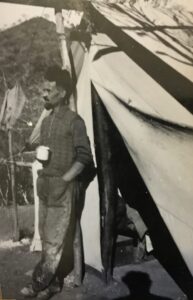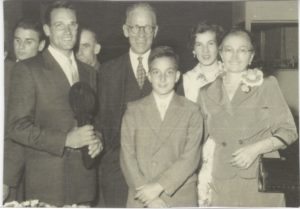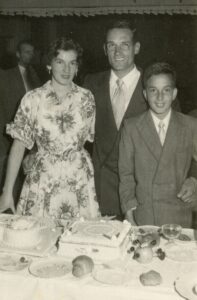In the photo above, Lina and Gelindo Rossetto are seated with their children, Aldo, Romeo and Lena.
The photo was taken in Adelaide in about 1937.
It was supplied by Lena Moscheni nee Rossetto.
The experience of Gelindo Rossetto (one of the Veneto market gardeners who arrived in Adelaide in 1927) during the war differs from the rest of the Veneto market gardener group because he combined three roles: market gardener, mica miner and political activist.

When the war began, Gelindo had been in Adelaide for 12 years and he and his wife, Lina nee Bordin, had three children, Romeo, Lena and Aldo. (Silvano was born in 1943. Romeo died in 1938, aged 7 years and two other children died as infants)
The market gardener
Unlike others in the Veneto community, Gelindo and his wife and their three children had moved away from the Lockleys area. They lived in the west end of the City of Adelaide from about the mid-1930s. Gelindo cycled eight kilometres to work his market garden.
Gelindo had grown vegetables on leased land at Lockleys on the River Torren beside the bridge on Rowells Road for several years. He had about 20 glasshouses and with Lina’s assistance, grew tomatoes, potatoes, cabbages, cauliflowers and other ‘outside’ vegetables. When his brother, Giuseppe Rossetto arrived in 1938, he worked in the market garden when Gelindo was away.
The mica miner – and market gardener

In the mid 1930s, Gelindo bought a share in a mica mine at the same time as Angelo Piovesan, one of the other Veneto market gardeners. The ‘Spotted Tiger’ mine was in the Harts Ranges about 1,700 miles north of Adelaide. There had been a large presence of Italian mica miners in the Harts Ranges from the 1930s. Working the mine gave Gelindo and Angelo the opportunity to increase their income as their families grew – and profits from the market gardens were not consistent.
Gelindo’s daughter, Lena Moscheni, was interviewed in 2014 and she remembered that it was not always possible for her parents to sell the vegetables in the 1930s:
During Depression time, they used to go to the market with their vegies, and couldn’t sell them because nobody had money, so they used to bring them all back and bury them into the garden, back into the garden. I remember that.
Lena Moscheni nee Rossetto, OH 872/32, 28 August 2014, p 13
Both Gelindo and Angelo alternated work on the mine and the market garden. The financial return from mica mining became very lucrative during the war because mica was used in electronic equipment, insulation and airplane instruments.
Conscription to the civilian workforce
Gelindo, like the other market gardeners, was conscripted to the Australian Government civilian labour force to assist with the war effort by building infrastructure such as airstrips, roads, pipelines, stores etc. The manual work was undertaken in remote work camps with pay and conditions that were considered sub-standard. In June 1943, Gelindo received instructions to travel to the Northern Territory where he was assigned work with the Civil Constructional Corps. Through a lawyer, he applied for an exemption because of the need to work his market garden. The lawyer explained that Gelindo had a tomato crop worth $500 and he supplied vegetables for the Army and Gelindo’s brother was not able to manage the market garden and sales alone. The lawyer also added that Lina was seven months pregnant. Gelindo’s exemption was rejected at first but he was granted periods of leave without pay to remain with his wife.
The political activist, miner, market gardener
Gelindo took liberties with instructions from the Civil Constructional Corps, was prosecuted and fined for absence without leave. During this time, in addition to being with his wife and children, Gelindo was an active member of the Italia Libera (or Free Italy) movement in South Australia.

Italia Libera had been founded in Melbourne in 1943 as an anti-fascist organisation that aimed to support the allied countries and restore democracy in Italy and it had links to groups of Italian migrants in other countries. Members of Italia Libera distributed political materials such as the fortnightly newspaper, Risveglio (or “Awakening”) to members in the civilian labour camps and campaigned for issues such as parity of pay for different kinds of work undertaken by conscripts. The Australian Government assumed that it was a radical organisation and the South Australian Investigation Branch identified Gelindo as one of five Italians involved in the movement.[1]
Gelindo’s son, Aldo, remembered that his father was a strong opponent of fascism before he left Italy:
In the mid-1920s when Mussolini came to power and fascism was getting stronger, he disliked that intensely …. he wouldn’t stand for the fact that the fascists used to go around from village to village,
and if they didn’t convert you to fascism or you wouldn’t turn, they would beat you and make you drink castor oil as a result.
Aldo Rossetto OH 872/16, 4 July 2011, p 2.
About a year after serving with the Civil Constructional Corps, Gelindo was discharged in 1944. Although the reason for Gelindo’s discharge was because of his agricultural work, he began official duties as secretary with the State branch of Italia Libera in November 1944 when there was an estimated 60 members including men who were interned and conscripted civilians. Other Veneto market gardeners who remained on their land during the war were focused on their livelihoods and families. It seems that Gelindo was the only open political activist in the Veneto market gardener community during the war.


You can listen to interviews with Lena Moscheni nee Rossetto and Aldo Rossetto, daughter and son of Gelindo. Other Rossetto relatives also recorded interviews for the project and you can listen to them too. Use this link to access the interviews and some transcripts:
Click here to access the Rossetto family page
Madeleine Regan
8 September
[1] National Archives of Australia: D1915: SA20480 – Investigation Branch, South Australia.
